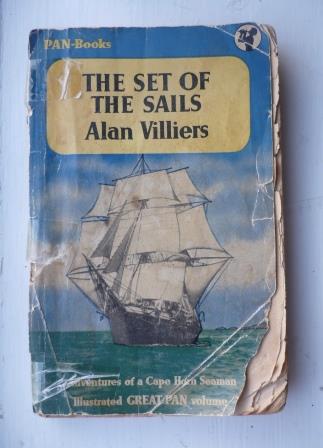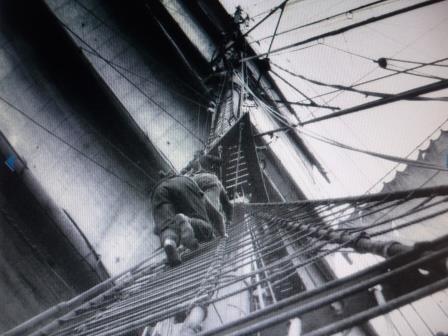Rating: 




I like brand new, shiny books as much as anyone. But every now and again an old, scruffy paperback a minute away from the rubbish bin proves to be a real gem. Such was ‘The Set of the Sails’, the 1949 autobiography of Alan Villiers (1903- 1982).
- The Set of the Sails (Pan paperback-condition as found)
Alan Villiers was the second son of Australian poet and union leader Leon Villiers. The young Villiers grew up on the docks watching the merchant ships come in and out of the Port of Melbourne and longed for the day on which he too could sail out to sea.
“Truly the voyage of the deep-sea sailing ship is a triumph of circumstance, an achievement of the apparently impossible, an adventure, and an outlet for romance in a world in which there exists too few of either”
Leaving home at the age of 15, he joined the barque Rothesay Bay as an apprentice. The Rothesay Bay operated in the Tasman Sea, trading between Australia and New Zealand. Villiers was a natural seaman. He learnt the ropes quickly and gained the respect of his shipmates.
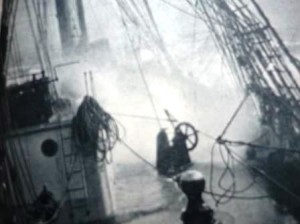
He served altogether five years in square-rigged ships. At the age of seventeen, sailing out of Bordeaux on the Lawhill , the ship collided with a buoy off Port Lincoln and he was pitched off the yard, striking the rigging all the way in his fall to the deck. On his return to Australia, he spent time as a journalist in Hobart, Tasmania, but in 1931 he became part-owner of the four-masted barque Parma, which twice won the grain race from Australia to England. In 1934 he purchased the Danish sail training ship George Stage, renamed her Joseph Conrad, manned her with cadets, sailed round the world in her, logging 92,800 kilometres (58,000 mls.), and then wrote an account of his experiences in The Cruise of the Conrad (1937). Before the Second World War (1939–45) he sailed in Arab dhows on the Persian Gulf–Zanzibar run.
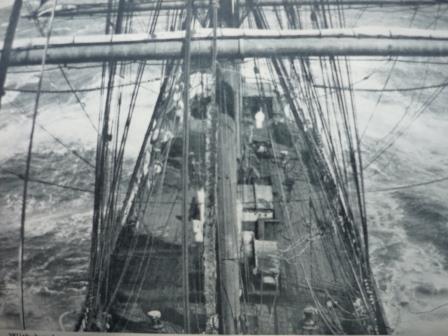
Married in 1940, Villiers settled in Oxford, England, and continued to be active in sailing and writing. He was the Captain of the Mayflower II in her 1957 maiden voyage across the Atlantic, and beating her predecessor’s time of 67 days by 13 days. He has been involved in almost every large historical sailing ship still in existence including the Balclutha (1886) , the USCGC Eagle , the Falls of Clyde , the Gazela, the Sagres II, and he would also prove instrumental in the restoration of the Star of India. Cadets at the Outward Bound Sea School in Wales remember him as skipper of their training ship Warspite. He was also involved in the creation of the HM Bark Endeavour replica, and advised on the 1962 movie Mutiny on the Bounty. Villiers was a regular contributor to the National Geographic Magazine throughout the 1950s and 1960s, recording the passing of the age of sail and contemporary maritime heritage.
Describing one of his more difficult voyages, on board the Grace Harwar:
“There was far from enough to eat in the ship that voyage. That saved many of us, I think, though it did not occur to us at the time as being in any way a good thing. We were forced to lead a monkish sort of life, undernourished, fighting adversity with insufficient rest. A full belly is no aid to reflection. Our near empty bellies, week after week, sharpened our minds.We were forced to find our souls, if we had no knowledge of them before.We were forced in humility to accept the help of God, or we could not have gone on. There was no escape , and there were no distractions. Yet I know I was never clearer-headed in my life.I was one of a handful of able seamen in a heavy ship, grievously undermanned. I steered. I pumped. I worked aloft. I often sewed sails all day on deck, and worked with them in the rigging half the night..Yet I would have filled my belly, had I had the chance; and I have lacked the character to recreate the circumstances since, though almost forced to do so in small ocean going ships during the 1939-45 war.” (p207)
Villiers wrote 25 books, and served as the Chairman of the Society for Nautical Research, a Trustee of the National Maritime Museum, and Governor of the Cutty Sark Preservation Society. The photographic work of Alan Villiers is arguably the most important photo-historical record of early 20th-century maritime history. He was awarded the British Distinguished Service Cross as a Commander in the Royal Naval Reserve during World War II. He commanded landing craft squadrons during the invasions of Italy and Normandy, and afterwards in the Far East.
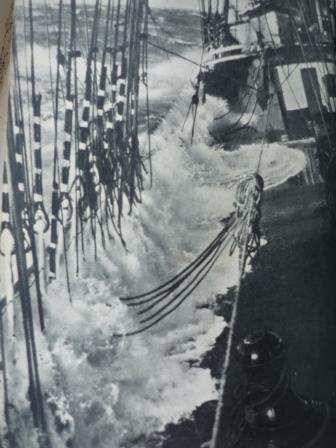
He was fourteen when he lost his father. The powerful way he recalls that time is as fitting a tribute to son as to father:
“When we reached the hospital, where he expected to be an outpatient for perhaps a few weeks, he was at once admitted. There was an operation for cancer, which was far advanced. It was hopeless. He was sewn up again. They gave him drugs. Within a week, he had died. They brought him home in his coffin, which was left with the lid not yet screwed down, in our darkened front room.
When all his relations, friends and colleagues had paid their last respects, I went in. He looked peaceful lying there, and it seemed to my youthful eyes that he was better dressed in the undertaker’s clothes than I had ever seen him in life. I touched the high forehead. It was cold. The lips were grey, and the blue eyes had smiled for the last time. What an end was this, to a full life of brave and unlimited endeavour! To be shut there in a long black box, helpless, hopeless, finished, gone. There was a plaque on the coffin-lid:
LEON JOSEPH VILLIERS, BORN AT MELBOURNE DECEMBER 25, 1872, THE SON OF FRANK AND CATHERINE VILLIERS. DIED APRIL 10, 1918.
He was born. He lived forty-five years. He died. At his feet lay heaps of his manuscripts, his Songs of Labour and of Love, his poems of the Australian bush, now never to be revised. All his great hopes for his country and for us, his sons, were in that coffin too; somehow I knew that. He was an Australian of great vision and abiding faith in the destiny of the southern commonwealth; none of us would ever approach the standards set by him, or even begin to appreciate, for years, the values by which he had lived. He had risen above his environment, and he had taken us with him though we were all so young when he died.
Next day they threw earth down on the coffin, in a corner of the Cobourg cemetery, and the dull thud of the clods was an agony to hear. I thought of many things as I stood there. What was it he had said? “Do not take my conduct for your precepts, but my advice.” I knew that if the pattern of my conduct throughout my life came near to his, then I would have little heed to remember the advice.” (p16)
In short, this is a book by a real enthusiast describing a life full of drama and combat with the “savage, endless enmity” of the wind and the waves. I will be looking out for more books by Alan Villiers.
Thanks to:
